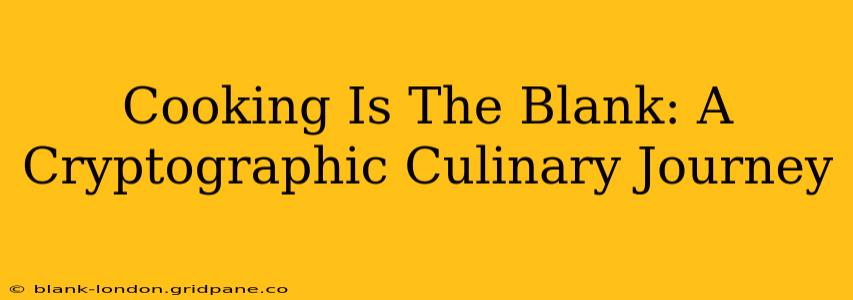Cooking. It's more than just sustenance; it's an art, a science, a form of self-expression, and, surprisingly, a surprisingly apt metaphor for cryptography. This article explores the fascinating parallels between the culinary arts and the world of secure communication, revealing how the seemingly disparate fields share a surprising amount in common. Think of this as a cryptographic culinary journey, where we'll decipher the hidden flavors and unlock the secrets behind both.
What are the Similarities Between Cooking and Cryptography?
At first glance, cooking and cryptography might seem worlds apart. However, a closer examination reveals striking similarities:
-
Precision and Measurement: Just as a chef meticulously measures ingredients to achieve the perfect balance of flavors, a cryptographer carefully measures and manipulates data bits to ensure security. Incorrect measurements in either field can lead to disastrous results – a bland dish or a compromised system.
-
Secret Ingredients (Keys): Every great chef has their secret ingredient, a special touch that elevates their dishes. In cryptography, this "secret ingredient" is the encryption key. Without the correct key, the "dish" (the encrypted message) remains undecipherable.
-
Transformation and Encryption: Cooking transforms raw ingredients into a delicious meal. Similarly, cryptography transforms plaintext into ciphertext, rendering it unreadable to unauthorized individuals. The process of cooking, with its various techniques and methods, mirrors the intricate algorithms used in encryption.
-
Security and Integrity: Chefs take great care to ensure food safety and prevent contamination. Cryptographers employ various techniques to protect data integrity, prevent tampering, and ensure authenticity. Both prioritize the preservation of their "creation" against unwanted changes or intrusions.
What are the Different Types of Cryptographic Cooking Techniques?
We can even draw parallels between specific culinary techniques and cryptographic methods:
-
Symmetric Encryption (The Simple Recipe): Like a simple, straightforward recipe that anyone with the instructions can follow, symmetric encryption uses the same key for both encryption and decryption. Think of a basic stir-fry – the ingredients (data) are combined (encrypted) using a specific method (the key), and anyone with the recipe (key) can recreate the dish (decrypted data).
-
Asymmetric Encryption (The Secret Sauce): Asymmetric encryption, on the other hand, uses two separate keys – a public key for encryption and a private key for decryption. This is like a complex dish with a secret ingredient only the chef knows – the public key allows anyone to encrypt a message, but only the chef (with the private key) can decipher it.
-
Hashing (The Recipe's Fingerprint): Hashing functions generate a unique "fingerprint" of the data, ensuring data integrity. Think of this as a unique identifier for a dish – the recipe might change slightly, but the overall taste and characteristics would allow you to identify it.
-
Digital Signatures (The Chef's Signature): Digital signatures verify the authenticity and integrity of data, much like a chef's signature on a menu guarantees the quality and origin of the dish.
How Can I Use This Knowledge In My Daily Life?
Understanding the cryptography-cooking analogy can improve our appreciation of both fields. It highlights the importance of precision, security, and the ingenious methods involved in creating both delicious meals and secure communication systems. While you won't be using cryptographic algorithms while chopping vegetables, the parallels demonstrate the power of systematic processes and the importance of protecting your "creation"—whether it's a delicious meal or sensitive data.
Frequently Asked Questions (FAQ)
What is the most important aspect of cryptography in cooking?
The most important aspect is the careful and precise "measurement" of your ingredients and methods, just like the meticulous attention to detail needed in cryptography to ensure secure communication.
How does encryption relate to cooking?
Encryption transforms readable data into an unreadable format, just like cooking transforms raw ingredients into a palatable dish. Both processes involve transformations that require specific "keys" or methods to reverse.
Can I learn cryptography through cooking?
While you won't directly learn the technical details of cryptography by cooking, understanding the parallels can help grasp the core concepts of data transformation, security, and the importance of precise methodologies.
Is there a cryptography cookbook?
Not literally, but this analogy provides a framework to understand some core principles of cryptography in a relatable and accessible way.
This culinary cryptography journey hopefully sheds light on the often-overlooked similarities between two seemingly disparate fields. It is a testament to the universality of underlying principles and the power of analogies in helping us understand complex concepts.

